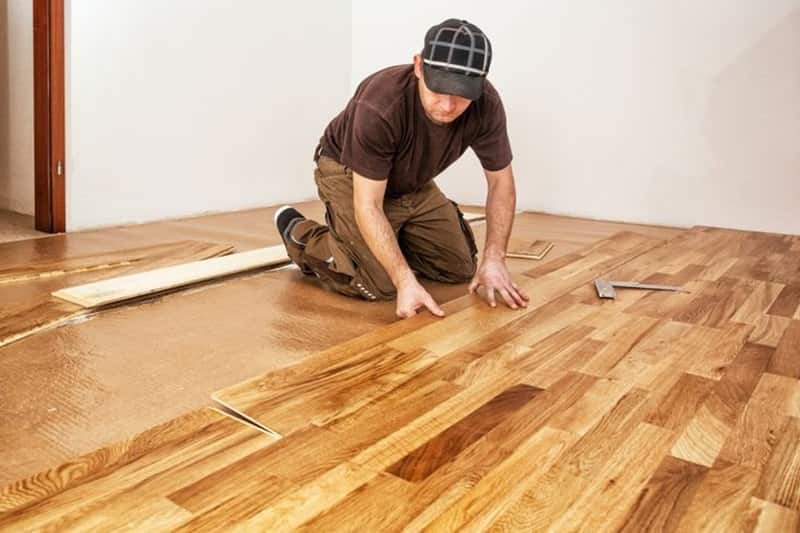Vinyl flooring is a popular choice for its durability, affordability, and easy maintenance. However, over time, vinyl floors may start to develop a yellowish tint, which can be unsightly and concerning. Let’s find the causes of vinyl floor yellowing and provide effective solutions to restore the floor’s original appearance.
What are the causes of vinyl floor yellowing?
1. Exposure to Sunlight
Vinyl flooring is sensitive to UV radiation. Prolonged exposure to direct sunlight can cause vinyl to discolor and turn yellow. This is especially common in areas with large windows or glass doors.
2. Chemical Reactions
Certain chemicals and cleaning products can react with the vinyl flooring surface, leading to discoloration and yellowing. Harsh cleaning agents or improper use of chemicals not specifically formulated for vinyl floors can contribute to the yellowing effect.
3. Wax or Polish Buildup
If you apply too much wax or polish to your vinyl floor and fail to remove it properly, it can build up over time and turn yellow. It’s essential to follow the manufacturer’s recommended cleaning and maintenance guidelines.
4. Moisture and Mold
Excessive moisture or water infiltration can seep beneath the vinyl and cause it to discolor. This can be due to water leaks, high humidity, or improper installation. Mold growth can also lead to yellowing and should be addressed promptly.
5. Inadequate Cleaning
Improper cleaning methods or the use of harsh chemicals can strip the protective finish on the vinyl, leaving it susceptible to yellowing. Using non-recommended cleaning agents or abrasive scrubbers can damage the surface.
6. Aging
Over time, vinyl flooring can naturally yellow due to the breakdown of its composition. This aging process is unavoidable and can be accelerated by factors like heavy foot traffic and inadequate maintenance.
7. Wear and Tear
Over time, general wear and tear, such as foot traffic, furniture movement, or friction from cleaning, can cause the protective layer of the vinyl flooring to wear down. This wear can expose the underlying layers, which may contribute to yellowing.
Solutions to Remove Vinyl Floor Yellowing
1. Preventive Measures
- Sunlight/UV Protection: Use blinds, curtains, or UV-resistant window films to minimize direct sunlight exposure on the vinyl floor. This can help reduce the risk of discoloration and yellowing over time.
- Use Appropriate Cleaning Products: Use cleaning products specifically formulated for vinyl floors. Avoid harsh chemicals, ammonia-based cleaners, or abrasive materials that can cause damage and yellowing.
2. Cleaning and Maintenance
- Regular Cleaning: Implement a regular cleaning routine using a mild, non-abrasive cleaner recommended for vinyl floors. This helps remove dirt, grime, and potential sources of yellowing.
- Gentle Scrubbing: Use a soft mop or microfiber cloth to gently scrub the floor surface, focusing on any areas that show signs of yellowing. Avoid abrasive brushes or scouring pads that can cause further damage.
- Vinegar Solution: For light yellowing, mix a solution of equal parts water and white vinegar. Apply the solution to the affected areas and gently scrub. Rinse with clean water and dry the floor thoroughly.
- Commercial Vinyl Restorers: If mild cleaning methods do not restore the floor’s color, consider using a commercial vinyl restorer or brightener. Follow the manufacturer’s instructions carefully and test the product in an inconspicuous area before applying it to the entire floor.
- Oxalic Acid Cleaner: Oxalic acid is effective at removing stubborn yellow stains. You can find specialized vinyl floor cleaners containing oxalic acid. Follow the product’s instructions for usage carefully, and ensure proper ventilation.
- Hydrogen Peroxide: Hydrogen peroxide can be effective at brightening yellowed vinyl. Mix a small amount with water (1:4 ratio) and apply it to the yellowed areas. Let it sit for a few minutes, then scrub gently and rinse thoroughly.
3. Floor Refinishing
- Wax or Polish: For vinyl floors with a wax or polish layer, applying a fresh coat of wax or polish can help restore the floor’s shine and minimize the appearance of yellowing. Follow the manufacturer’s instructions for application.
- Floor Stripping and Re-sealing: In more severe cases of yellowing, it may be necessary to strip the existing finish and re-seal the vinyl floor. This process should be performed by professionals to ensure proper removal of the old finish and application of a new sealant.
4. Consider Replacement
- If the yellowing is extensive and cannot be remedied through cleaning or refinishing methods, it may be necessary to consider replacing the vinyl flooring. Consult with flooring professionals to explore replacement options that suit your needs and budget.
Conclusion
Vinyl floor yellowing can be a frustrating issue, but there are various solutions available to restore the floor’s original appearance. Implementing preventive measures, using appropriate cleaning products, and regular maintenance can help minimize the risk of yellowing.
In cases where yellowing has occurred, gentle cleaning methods, commercial vinyl restorers, or floor refinishing techniques can often improve the floor’s color and restore its beauty.
If all else fails, considering replacement may be the best course of action. By taking the necessary steps to address vinyl floor yellowing, you can maintain a clean, vibrant, and visually appealing vinyl floor in your home or commercial space.


